牛津高中英语模块四unit1—1教案(advertising)
- 格式:doc
- 大小:149.55 KB
- 文档页数:18
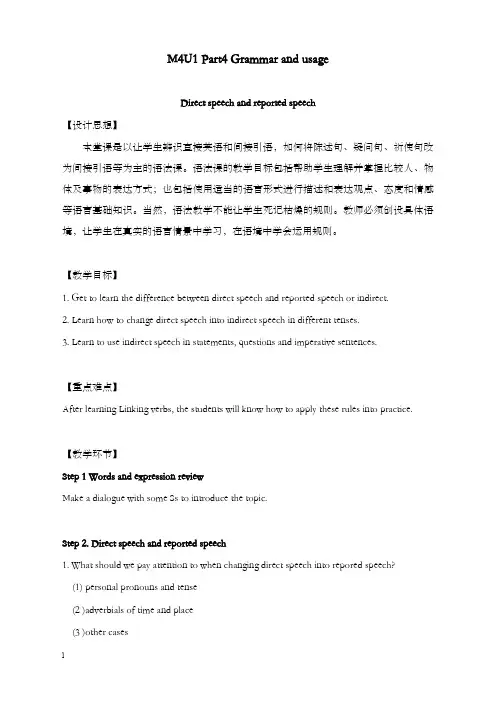
M4U1 Part4 Grammar and usageDirect speech and reported speech【设计思想】本堂课是以让学生辨识直接英语和间接引语,如何将陈述句、疑问句、祈使句改为间接引语等为主的语法课。
语法课的教学目标包括帮助学生理解并掌握比较人、物体及事物的表达方式;也包括使用适当的语言形式进行描述和表达观点、态度和情感等语言基础知识。
当然,语法教学不能让学生死记枯燥的规则。
教师必须创设具体语境,让学生在真实的语言情景中学习,在语境中学会运用规则。
【教学目标】1. Get to learn the difference between direct speech and reported speech or indirect.2. Learn how to change direct speech into indirect speech in different tenses.3. Learn to use indirect speech in statements, questions and imperative sentences.【重点难点】After learning Linking verbs, the students will know how to apply these rules into practice.【教学环节】Step 1 Words and expression reviewMake a dialogue with some Ss to introduce the topic.Step 2. Direct speech and reported speech1. What should we pay attention to when changing direct speech into repored speech?(1) personal pronouns and tense(2 )adverbials of time and place(3 )other casesStep 3. How to use reported speech to report(the style used inwriting to reportwhat someone saidwithout repeatingtheir actual words.)【要点】(根据学whether生情况可作调整)1. 标点符号的变化:He said to me, “Don’t live in London!”= He told me not to live in London.2. 语序的变化:疑问语序变为陈述语序。
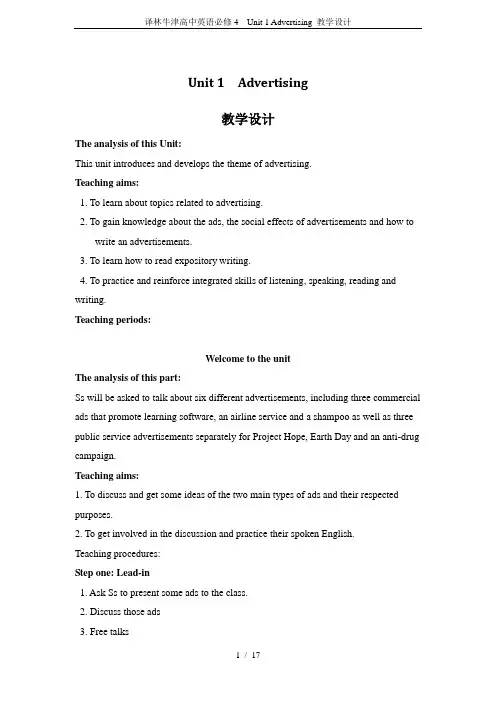
Unit 1 Advertising教学设计The analysis of this Unit:This unit introduces and develops the theme of advertising.Teaching aims:1. To learn about topics related to advertising.2. To gain knowledge about the ads, the social effects of advertisements and how towrite an advertisements.3. To learn how to read expository writing.4. To practice and reinforce integrated skills of listening, speaking, reading and writing.Teaching periods:Welcome to the unitThe analysis of this part:Ss will be asked to talk about six different advertisements, including three commercial ads that promote learning software, an airline service and a shampoo as well as three public service advertisements separately for Project Hope, Earth Day and an anti-drug campaign.Teaching aims:1. To discuss and get some ideas of the two main types of ads and their respected purposes.2. To get involved in the discussion and practice their spoken English.Teaching procedures:Step one: Lead-in1. Ask Ss to present some ads to the class.2. Discuss those ads3. Free talksa) Where do you find these ads?b) What are ads used for?Suggested answers:a) on billboards, TV, the radio in magazines/newspapers/leaflets given out in the streets.b) To promote a product or services, to believe in an idea.To educate people about health, safety or any other issue which affects public welfare.Step two: Picture talking:1. Project Hope---How do you feel when you see the child in the big eye?---What would you like to do for the child after seeing this ad?----What do you think the purpose of Project Hope is ?[来源:学科网ZXXK]This picture is intended to make people aware of the importance of Project Hope.It makes people realize that there are still a lot of children dropping out of school for economic reasons. It calls upon people to do sth. to help children in poor areas. The picture makes us aware of the needs of other people.The purpose of Project Hope : It aims to help young people who have dropped out of school return to school. It aims to develop basic education in poor areas in child, especially in western china, with money collected from society. Nowadays it pays special attention to children of laid-off workers in cities.2. the software ad--- What do you know from this ad?--- If you intended to buy some cheap learning software, would this advertisement help you?3. Oxlin Airlines---- What does the advertisement try to sell a product or service?4. Earth Day----Why does this ad. Use the image of a bird’s nest?----Do you think this advertisement helps to make people aware of environmental problems?----What do you think Earth Day is all about ?Earth Day aims to increase environmental awareness and encourage people to take care of the Earth and its people. The first Earth Day was celebrated on 21 March, 1970. The reason why it fell on that day is that night and day are equal throughout the Earth on that day. Today Earth Day is celebrated annually by almost every country throughout the world.5. Say no to drugs---the anti-drugs campaign[来源:]------Do you think drugs are harmful?------If someone takes drugs, what coul d happen to him or her?------Does the ad teach you about the bad effects of taking drugs?What are they?6. the Shampoo ad----what kind of people do you think this ad is targeting? Why?----Younger people, especially girls or females. Because they pay more attention to their appearance.---hair.------Do you think this ad will successfully persuade people to buy this shampoo? Step three: Discussion1. Ask Ss to discuss th ree questions in pairs or groups.2. summary.Step four: Language focus1. advertise ---advertising advertiser advertisement登广告:在公告,如报纸上询问或寻找:advertise for an apartment.登广告寻求公寓房2. make sb. aware ofWhat the teacher said made me aware of the importance of English.Be aware ofThe little child is not aware that he is faced with danger.You are not aware how worried I felt about your safety.3.dangerC/n Waste must be treated so that it does not become a danger to life.That man is a danger to society.C/n A soldier’s life is full of danger in war.In danger (of ) …. / out of dangerThe man is in danger because the tiger besides him is dangerous.4. similar be ~ toSimilarityThere are some similarities and diffe rences between American English and Britain English.Your views on education are ~ to mine.5. may have doneHe may have missed his train.They may not have finished the work by now.Homework 1. preview reading part2. Translation1. 这家旅馆提供练好的服务。

Unit 1 AdvertisingProjectDeveloping an Ad CampaignTeaching Aims:●To learn about some basic information about an ad campaign●To apply what they have learnt to develop an ad campaign Teaching Key Points & Teaching Difficulties:How to help them to develop an ad campaignThe usage of some key wordsTeaching Procedure:Step One: ReadingT: (Greet the class as usual) In this unit we have learnt what an advertisement is and even have written one in the last lesson.Then do you know what an ad campaign is?Ss: No.T: Ok. In this lesson we will go on with this topic. Please open your text books at page 18. Read the article silently as quicklyas possible to answer the following questions:1)What is an ad campaign?2)What must you have in mind when you start a successful adcampaign?3)What questions must you first consider in an ad campaign?Ss: …Suggested Answers:1.It is an organized programme of advertisements usingvarious kinds of ads to reach a particular audience.2.We must have a clear goal and target audience in mind.3.We must first consider the following questions:Who is the audience for our ad campaign?What do we want our ad campaign to say?How do we reach our audience?T: Very good! Now I think you have got a general idea of the passage. In fact, nowadays people all over the world use themedia to advertise for the benefit of the public or publicwelfare.Read the second article and answer.1. What is the subject of this ad campaign?2. Why do they build this ad campaign?3. Who is the target audience for this ad campaign?4. What is the ad campaign aimed to do?5. What is the slogan for this campaign?Suggested Answers:1. Anti-smoking.2. Because the problem costs countries a lot of money and causes greatdamage to thewelfare of the people.3. High-school teenagers.4. To discourage young people from smoking.5. Smoking kills!Step Two: Developing an ad campaignT: Ok, next we will plan and conduct an ad campaign, promoting a public welfareproblem. Discuss the questions on Page 19 with your group members. Planning:Decide which subject you are interested in and choose one for your ad campaign. You should have a clear idea of the goal, the target audience, the message of your ad and the media you will use.Preparing:Divide the work to each group member.Producing:Put what you have written together and add a logo. You must proofread your ad campaign proposal and correct mistakes if they are any. Presenting:Present your ad campaign to the class.Step Three: Homework:To do Parts B1 and B2 on Page 91 in Workbook. To do Parts D1 and D2 on Page 93 in Workbook.。
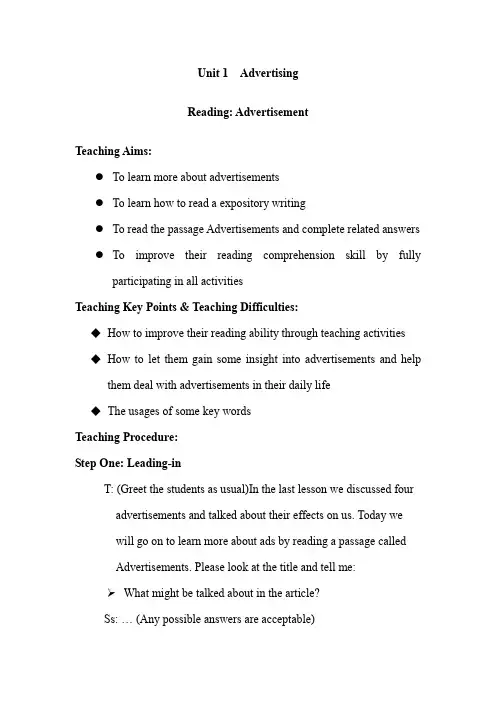
Unit 1 AdvertisingReading: AdvertisementTeaching Aims:●To learn more about advertisements●To learn how to read a expository writing●To read the passage Advertisements and complete related answers●To improve their reading comprehension skill by fullyparticipating in all activitiesTeaching Key Points & Teaching Difficulties:◆How to improve their reading ability through teaching activities◆How to let them gain some insight into advertisements and helpthem deal with advertisements in their daily life◆The usages of some key wordsTeaching Procedure:Step One: Leading-inT: (Greet the students as usual)In the last lesson we discussed fouradvertisements and talked about their effects on us. Today wewill go on to learn more about ads by reading a passage calledAdvertisements. Please look at the title and tell me:What might be talked about in the article?Ss: … (Any possible answers are acceptable)(This step is to help them predict the contents of the passagewhich is of great help to improving their reading comprehensionability)Step Two: Reading ComprehensionT: Very Good! Now let’s read the article to check whether your prediction is correct or not. First of all, please open your bookto page 2. Go through the questions in part A first and then readthe text silently to find the answers to the three questions:1)What do ads try to persuade people to do?2)What does PSA stand for?3)What do PSAs aim to do?(Remind students to use skimming and scanning skills to focus onand identify the information needed to answer these questions.Let them pay attention to the three subtitles in the passage whichcan help them find the information they want. )Ss: … (Encourage them to give their answers in their own words.)Suggested Answers:1)To buy a product service or service, or to believe in an idea.2)Public service advertisements3)They aim to teach us and help us lead better lives.T: Wonderful! Since we read the article once, I think you can ageneral idea of the passage. But if you want to get a betterunderstanding of the article, you should read an article severaltimes. So please look at Part C1 on page 4. Do the true and falseexercise.Part C1:●Most people are not aware of how many ads are around them.●Advertisements are always meant to promote a product orservice.●PSAs are only found in newspapers and on TV.●PSAs and commercial ads use some of the same methods.●Commercial ads often give us valuable information about how tolive our lives.●An ad warning people against smoking is an example of a PSA. Ss: … (Ask them finished it individually)Suggested Answers:1. T2. F3. F4. T5. F6. TT: Great! Now I think most of you have got a better understanding of the article. Next let’s go on to do the exercise in Part C2. Please go over the article again and answer the following questions.Part C2:●Where are advertisements usually found?●What is the major distinction between commercialadvertisements and PSAs?●Why are some of the advertisements clever according to thearticle?●When did China begin a nationwide public serviceadvertising campaign?●Why should we follow the advice in PSAs?Step Three: Reading StrategyT: Now you have read the article twice. I think most of you have no difficulty in understanding it. Yet different types of passagesrequire different reading strategy. The article we have learnt is anexpository writing. Then:Do you know how to read an expository article?Ss: No.T: Ok. Please read the reading strategy on page 3 and try to answer the two questions:1)What is expository writing meant to do?2)What is its basic format?Ss: …(Remind them to concentrate on the letters in bold )Possible Answers:1)It is meant to introduce you to basic information on a topic.2)It usually follows the basic format: introduction of the subject,examples and facts that develop or support the idea,conclusion.T: Good! If you read expository writing in future, remember to use what you have learnt today. It will help you get a good understanding of the passage and improve your reading ability.That’s all for the reading. If you have any problem, please point it out and ask me for help.(Give explanations if necessary and ask them complete the left exercises after class.)The Keys to Part D:1.h2.c3.b4.d5.f6.g7.e8.aThe Keys to Part E:1.dealing withments3.promote4.fool5.even if6.cheated7.campaigns8.benefitStep Four: Post-reading DiscussionT: Well done! Last but not least, work in pairs and discuss these questions with your partner.1)What are the differences between commercial ads and publicservice ads?2)Do you think young people are easily persuaded by ads? Why orwhy not?3)What is the best PSA you have ever seen? Why do you think itis impressive?(This serves as a consolidating exercise for students to practise their spoken English. Encourage them to discuss freely and bravely in English and later ask some students to express themselves.)Step Five: Homeworkto complete the remaining exercises on Page 4 and 5.to do parts A1 and A2 on Page 90 in Workbook。
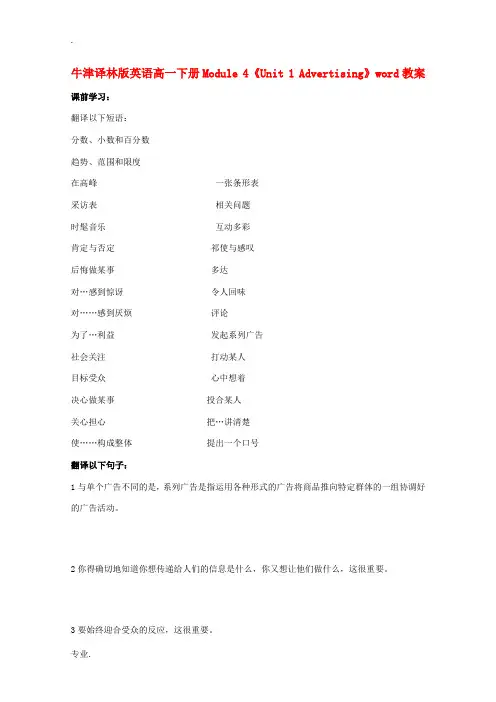
牛津译林版英语高一下册Module 4《Unit 1 Advertising》word教案课前学习:翻译以下短语:分数、小数和百分数趋势、范围和限度在高峰一张条形表采访表相关问题时髦音乐互动多彩肯定与否定祁使与感叹后悔做某事多达对…感到惊讶令人回味对……感到厌烦评论为了…利益发起系列广告社会关注打动某人目标受众心中想着决心做某事投合某人关心担心把…讲清楚使……构成整体提出一个口号翻译以下句子:1与单个广告不同的是,系列广告是指运用各种形式的广告将商品推向特定群体的一组协调好的广告活动。
2你得确切地知道你想传递给人们的信息是什么,你又想让他们做什么,这很重要。
3要始终迎合受众的反应,这很重要。
4选择广告方式的主要依据是目标受众,以及何种广告最能被这一特定群体所接受。
课堂学习1 design dresses /the National Stadium 设计服装/国家体育馆design a plot for one’s new novel为新小说拟定情节 a perfect crime 筹划一个天衣无缝的犯罪 the well paper design 墙纸的图案be of poor design 设计很差have designs on one’s money /life 觊觎某人的钱/想杀害某人by design 故意地2 react vi. (1)反应,反抗〔常与to连用〕How did your mother react to the news? She reacted by getting angry.你妈妈对这个消息的反应怎样?她的反应是非常生气。
The eyes react to light. 眼睛对光起反应。
(2)〔常与against连用〕反抗,反对Children tend to react against their parents by going against their wishes.孩子往往故意不听父母的话来示抗拒。
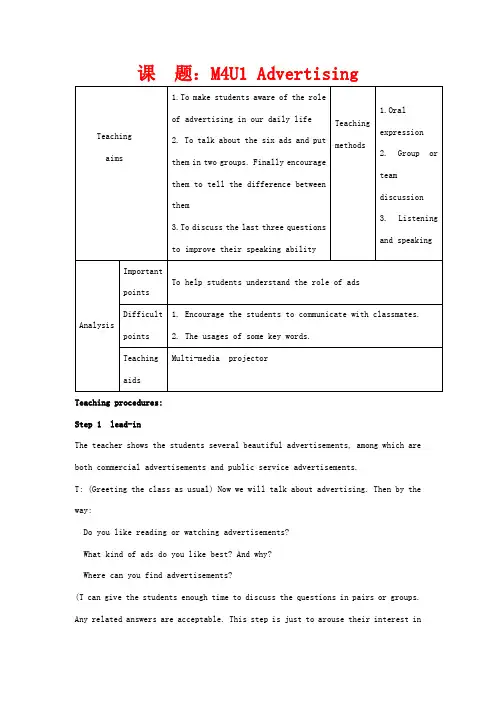
课题:M4U1 AdvertisingTeaching procedures:Step 1 lead-inThe teacher shows the students several beautiful advertisements, among which are both commercial advertisements and public service advertisements.T: (Greeting the class as usual) Now we will talk about advertising. Then by the way:Do you like reading or watching advertisements?What kind of ads do you like best? And why?Where can you find advertisements?(T can give the students enough time to discuss the questions in pairs or groups. Any related answers are acceptable. This step is just to arouse their interest inthe topic.)Ss: … (Encourage them to express themselves)T: That’s good! So in fact we are living in a wor ld of ads and whether you like or not, they are influencing our life. Ok, now please open your book to page 1. Here are four pictures. You may have seen some similar to them. Next please discuss them in groups of four and try to answer the following questions:What can you see in the picture? What can you read on it?What does it persuade us to do or what does it try to tell us?Ss: …(Show the pictures in pairs and let the students to discuss them one by one. Remember to give them enough time to think about the above questions)Step 2 ObservationAsk students to focus on the four advertisements on Page1. Encourage the students to form pairs and discuss the contents of each one and try to divide the four advertisements into two parts. Thus, encourage the students to pay attention to the functions of the commercial advertisements and public service advertisements. T: Well done! Now you can see that advertisements are a good way to sell products or services. They are also a good way to make people aware of the needs of others and the dangers around them. Next please look at the table below and then go through the four pictures again. Later on put each of them in the correct group.T: Wonderful. I think most of you have realized the difference between the two. And in the reading we will have a further discussion.Step 3 DiscussionOrganize the students into four groups and ask each group to talk about one of thefour pictures in front of the whole class. Each group should choose one representative to present their ideas to the whole class. The three questions can help the students to start the discussion.Provide the students more meaningful and interesting advertisements and encourage them to think about an appropriate slogan for each one.Step 4: DiscussionT: So, now look at the three questions and discuss them in groups of four.1) What was it? Now do you believe that advertisements tell the complete truth?2) What is/are your favorite advertisement(s) making you think about problems in society or about people who need help? Why?3) What do you think makes a good advertisement?Ss: …(T can help the students to conduct the activity and encourage them to work together to complete the task. Later let some students to show off.) T: Well done. Now I think most of you have know what an advertisement is and realize the role of them in our life.Step 5 HomeworkAsk students to look for more information about ads and make good preparations for the reading part. The students can surf the net if they have access to it. Language Points1. advertise (P1)⑴ v.为……做广告,登广告宣传advertise sth. in the news paperThe perfume has been adve rtised in all the major women’s magazines.这种香水在所有主要的女性杂志上都做了广告。
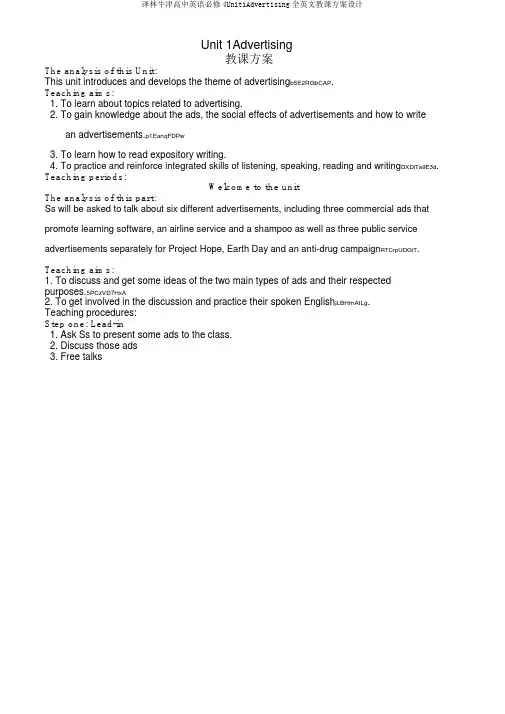
Unit 1Advertising教课方案The analysis of this Unit:This unit introduces and develops the theme of advertising b5E2RGbCAP.Teaching aims:1.To learn about topics related to advertising.2.To gain knowledge about the ads, the social effects of advertisements and how to writean advertisements.p1EanqFDPw3.To learn how to read expository writing.4.To practice and reinforce integrated skills of listening, speaking, reading and writing DXDiTa9E3d. Teaching periods:Welcome to the unitThe analysis of this part:Ss will be asked to talk about six different advertisements, including three commercial ads that promote learning software, an airline service and a shampoo as well as three public service advertisements separately for Project Hope, Earth Day and an anti-drug campaign RTCrpUDGiT. Teaching aims:1.To discuss and get some ideas of the two main types of ads and their respected purposes.5PCzVD7HxA2.To get involved in the discussion and practice their spoken English jLBHrnAILg.Teaching procedures:Step one: Lead-in1.Ask Ss to present some ads to the class.2.Discuss those ads3.Free talksa)Where do you find these ads?b)What are ads used for?Suggested answers:a) on billboards, TV, the radio in magazines/newspapers/leaflets given out in thestreets.xHAQX74J0Xb)To promote a product or services, to believe in an idea LDAYtRyKfE.To educate people about health, safety or any other issue which affects public welfare. Zzz6ZB2LtkStep two: Picture talking:1. Project Hope---How do you feel when you see the child in the big eye?dvzfvkwMI1---What would you like to do for the child after seeing this ad?rqyn14ZNXI----What do you think the purpose of Project Hope is ?EmxvxOtOcoThis picture is intended to make people aware of the importance of Project Hope SixE2yXPq5.It makes people realize that there are still a lot of children dropping out of school for economic reasons. It calls upon people to do sth. to help children in poor areas. The picture makes us aware of the needs of other people.6ewMyirQFLThe purpose of Project Hope : It aims to help young people who have dropped out of school return to school. It aims to develop basic education in poor areas in child, especially in western china, with money collected from society. Nowadays it pays special attention to children of laid-off workers in cities.kavU42VRUs2.the software ad---What do you know from this ad?---If you intended to buy some cheap learning software, would this advertisement helpyou?y6v3ALoS893.Oxlin Airlines---- What does the advertisement try to sell a product or service?M2ub6vSTnP4. Earth Day----Why does this ad. Use the image of a bird0YujCfmUCw’snest?----Do you think this advertisement helps to make people aware of environmentalproblems?eUts8ZQVRd----What do you think Earth Day is all about ?Earth Day aims to increase environmental awareness and encourage people to take care of the Earth and its people. The first Earth Day was celebrated on 21 March, 1970. The reason why it fell on that day is that night and day are equal throughout the Earth on that day. Today Earth Day is celebrated annually by almost every country throughout the world.sQsAEJkW5T5.Say no to drugs---the anti-drugs campaign------Do you think drugs are harmful?------If someone takes drugs, what could happen to him or her?GMsIasNXkA------Does the ad teach you about the bad effects of taking drugs?TIrRGchYzgWhat are they?6. the Shampoo ad----what kind of people do you think this ad is targeting? Why?7EqZcWLZNX----Younger people, especially girls or females. Because they pay more attention to their appearance.---hair lzq7IGf02E.------Do you think this ad will successfully persuade people to buy this shampoo?zvpgeqJ1hkStep three: Discussion1.Ask Ss to discuss three questions in pairs or groups NrpoJac3v1.2.summary.Step four: Language focus1. advertise ---advertising advertiseradvertisement 1nowfTG4KI登广告:在通告,如报纸上咨询或找寻:advertise for an apartment.登广告追求公寓房fjnFLDa5Zo2. make sb. aware ofWhat the teacher said made me aware of the importance of English tfnNhnE6e5.Be aware ofThe little child is not aware that he is faced with danger HbmVN777sL.You are not aware how worried I felt about your safety V7l4jRB8Hs.3.dangerC/n Waste must be treated so that it does not become a danger to life83lcPA59W9.That man is a danger to society.C/n A soldier’ s life is full of danger in war.In danger (of )/ ⋯out.of dangerThe man is in danger because the tiger besides him is dangerous mZkklkzaaP.4. similarbe ~ toSimilarityThere are some similarities and differences between American English and Britain English.AVktR43bpwYour views on education are ~ to mine.5. may have doneHe may have missed his train.They may not have finished the work by now.Homework1. preview reading part2.Translation1.家旅供给好的服。
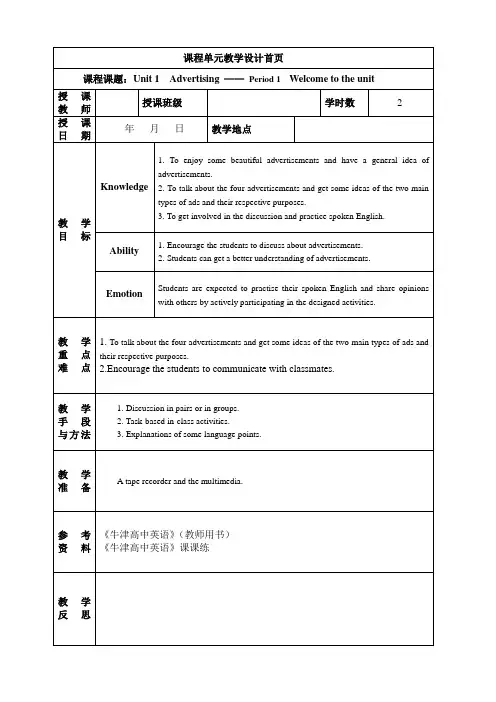

牛津译林版高中英语必修四课题:M4Unit1 Project 第10 课时总10 课时Teaching Procedures;Step 1: Lead-in1. Ask Ss to work in group of four and each student should find the general idea of each paragraph and tell his group member.2. Ask Ss to report their resulta) Para one: the definition of an ad campaignb) Para two: the target audience and how to determine the target audience.c) Para three: what the ad campaign saysd) Para four: how to reach the target audienceStep 2 : Reading1. Structure of this passagea) introduction of subjectb) supporting detailsc) conclusion2. More questions to understand this passage1) What do you know about an ad campaign?2) What must you keep in mind when you start a successful advertising campaign?3) Why do you need to research your audience?4) What is important when you are planning an ad campaign?5) What should your advertising campaign be based on?3. Use the same way to read the other article. Following questions will help you to understand it better.1)Why is anti-smoking chosen as the subject of the ad campaign?2)What is the main aim of the anti-smoking campaign?3)How can high-school teenagers be convinced not to start smoking? Step 3: Language focus:1. build—built---buil t①建立,创立:build a nation 建立一个国家built a successful business out of their corner grocery store.从他们街道拐角的杂货店创办了一家成功的公司②监督:命令、资助或监督…的建设:The administration built several new housing projects.行政部门资助了好几幢新楼的建筑项目We are building socialism with the Chinese characters.2. reach①被看到/听到Through television and radio we are able to reach a wider audience.②伸展,伸出,延伸:reached out an arm.伸出一只手臂③到达I hope this little will reach you.3.have …. in mind考虑When you’re going to do sth. you must have a clear target in mind. Watching TV all evening wasn’t exactly what I had in mind.have it in mind to do sth… 打算做某事You must have it in mind to post the letter for me.keep /bear … in mind 记住= learn by heartmake up one’s mind/change one’s mind 下定决心/改变主意4. figure out①理解,弄明白I can’t figure out why he quit his job.②想出,计算出Have you figure out how much the holiday will cost?He's trying to figure out a way to solve the problem.5. get … to do 使…做某事He got his sister to help with his homework.get … doing 使…开始做某事Can you really get the old car running again?What he said got me thinking.get … done 使…被做I got my pocket picked the other day.get done 表被动get hurt/burnt/separated6. determine v.确定;决定Vt.确定determine sth.They have determined the date for our party.Vi.决定determine to do sth.= be determined to do sth. 下定决心做He determined to get there first.= He was determined to get there first.determine on (doing )sth. 就……做出决定We determined on an early start.adj. determined 有决心的,决定的(在句中常作定语或状语)She is a very determined woman who always gets what she wants.be determined +从句/be determined to do sth.At the age of twenty, Steve left his hometown, determined not to return without making his mark. 在二十岁时,Steve离开了他的家乡,下定决心不搞出点名堂绝不回来。
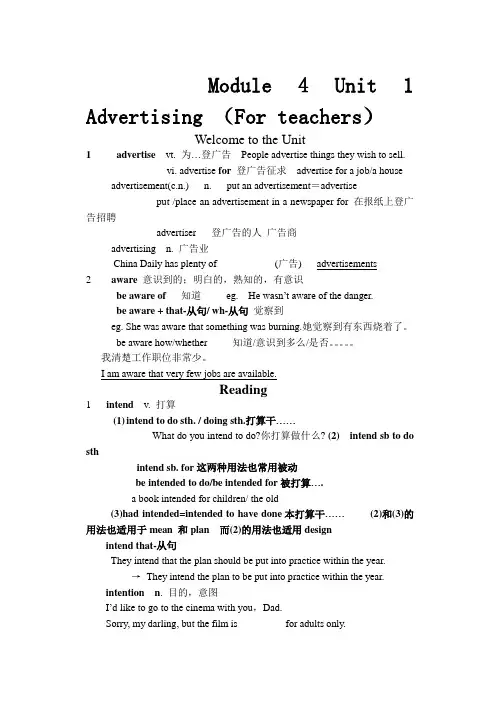
Module 4 Unit 1 Advertising (For teachers)Welcome to the Unit1 advertise vt. 为…登广告People advertise things they wish to sell.vi. advertise for登广告征求advertise for a job/a house advertisement(c.n.) n. put an advertisement=advertiseput /place an advertisement in a newspaper for 在报纸上登广告招聘advertiser 登广告的人广告商advertising n. 广告业China Daily has plenty of ___________(广告) advertisements2 aware意识到的;明白的,熟知的,有意识be aware of知道eg. He wasn’t aware of the danger.be aware + that-从句/ wh-从句觉察到eg. She was aware that something was burning.她觉察到有东西烧着了。
be aware how/whether 知道/意识到多么/是否。
我清楚工作职位非常少。
I am aware that very few jobs are available.Reading1 intend v. 打算(1)intend to do sth. / doing sth.打算干……What do you intend to do?你打算做什么? (2) intend sb to do sthintend sb. for这两种用法也常用被动be intended to do/be intended for被打算….a book intended for children/ the old(3)had intended=intended to have done本打算干……(2)和(3)的用法也适用于mean 和plan 而(2)的用法也适用designintend that-从句They intend that the plan should be put into practice within the year.→They intend the plan to be put into practice within the year.intention n. 目的,意图I’d like to go to the cinema with you,Dad.Sorry, my darling, but the film is _________for adults only.A admittedB intendedC promisedD permitted (B)2 。
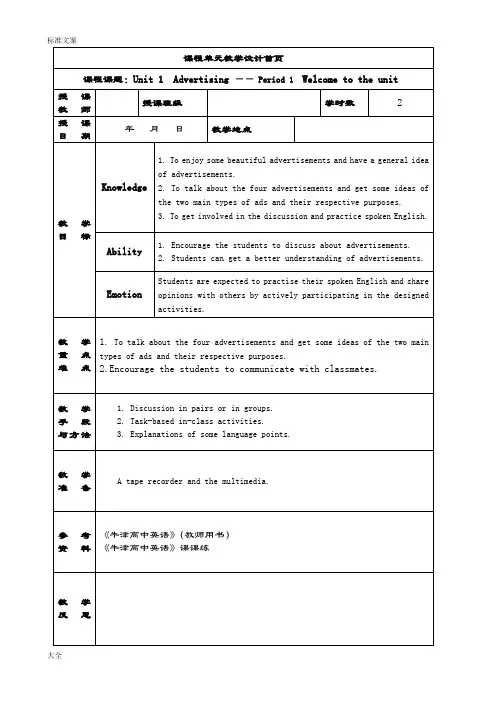
Unit 1 AdvertisingTaskWriting an AdvertisementTeaching Aim:●To train and improve the students’abilities of listening, speaking,reading, and writing●To learn how to listen for statistics and descriptions, and how to stateopinions and five supporting reasons●To apply what they have learnt to design a advertisement for achocolate barTeaching Key Points & Teaching Difficulties:✧How to improve their integrated skills through these activities✧How to help them to write an advertisement for a product✧The usage of some key words and structuresTeaching Procedure:Step One: Leading-inT: (Greet the class as usual) Today we will learn how to write an advertisement for a product. But first of all I want to ask you some questions. Since you have study English for years:Are you at listening?What difficulties do you have in listening?(It is to focus the students’attention on the thyme of this part.Encourage them to relate it to their own experiences and speak as they like.)Ss: ... (Any related answers are acceptable.)T: So that’s the problem. I think you need more practice to improve your listening skills. If so, you are sure to do it better.Step Two: ListeningT: Today in the first step we will learn how to listen for statistics.Now please open your book to page 12. Read the instructions (Group1 and 2) and consider the following two questions:What numbers are given when you listen for statistics?What phrases or phrases should you listen carefully for?(Let them read the content on page 12 and discuss them ingroups of four or so. Remind them to share their information. Tcan offer help if the students need it. Collect their answers asfollows.)Numbers in statistics:✧Fractions: 1/2(a/one half), 2/3(two thirds), 3/4(three quarters),etc✧Decimals: 0.3(zero point three), 6.79(six point seven nine), etc✧Percentages: 63%(sixty-three percent), 45.72(forty-five pointseven two), etcPhrases describing statistics:✧An increase: an increase of, increase/rise by, etc✧ A decrease: a decrease of, decrease/fall by, etc✧No change: no change, remain/stay the same, etc✧ A range: between … and …, from … to …, etc✧An average: average, etc✧ A limit: lowest, peak at, etc(Let them go over the above again and pay attention to the pronunciation of numbers. They can ask T for help if they have any questions. )T: OK. Now I think you have made it clear how to listen for statistics, and next you listen five short descriptions. Write down the statistics in the blanks. Remember you may need some simple calculations after listening.(Make sure they know what to do. Play the tape twice for them to complete the exercise. If possible, T can play a third time for the students to get a better understanding.)Suggested answers:1).1200, 1400 2).85%, 65% 3).50%~60%, 75.5%4).23.4%, 11.5%, 24.5%, 13.6% 5).9000, 3000T: Great! It’s a piece of cake for you. Next let’s go on to listen to an announcement. Write down the statistics to complete a chart.Yet some of the information is given to help you.T: So please use these statistics to complete part of the bar chart.The first has been given to help you.(Give them several minutes to finish. Be sure that they understand the instructions and know what to do.)T: (After a while) Now you can see some information in the table aremissing. Next please listen to the announcement and write down the numbers. Later we can complete the whole bar chart. Understand?Ss: Yes.(Play the tape at least twice for them to fill in the table. Ifnecessary, play it a third time for them to make sure of their answers. Collect the numbers in the table on the screen.)Sales of the ChocoLoco Bar 0510152025YearMarketShare %(Let them complete the above bar chart in their text books and then show the sample one on the screen for them to checkanswers.)Step There: DiscussionT: Very good! Later we will use the information collected in the bar chart to write an advertisement for the ChoccoLocoBar. But now I will give you a few questions for you totalk about in preparation for it.1)What’s your opinion of advertising in public places?2)What advertisements attract your attention?3)What do you think makes advertisements interesting?4)What have you seen in an ad and later bought?5)What’s your favorite advertisement? Why?Ss: …(Let them discuss the questions in groups of four. Remindthem to refer to the expressions listed on page 14 and inPart B on page 15 to complete the task.)Step Three: Writing an advertisementT: Now I think you have got something about what anadvertisement is and how to write one. Next let’s go on withthe next step. We will write an advertisement for a productChocoLoco Bar.T: Ok. Now let’s write an advertisement for the ChocoLoco Bar.The following must be included in your advertisement.Try our ChocoLoco Bar!Taste/look/ingredientswhat is unique about the productBenefitscomments from customersPrice/discountsWhere it is available(Ask them to do it in groups of four. Remind them that theycan add something related. If they can’t finish, let themcomplete it after class. They can surf the Internet to getmore help.)Step Four: Language points1.increase/rise/grow by …上涨了……increase/rise/grow to …上涨到……decrease/fall by …下降了……decrease/fall to …下降到……2.sth. end up with …某事以……结束/告终sb. end up sth. with …某人以……结束某事3.in one’s opinionin the opinion of sb. 在某人看来4.“数词+ more + 复数名词”或“another + 数词+ 复数名词”表示“还……;再……”e.g. The professor needs another two assistants to do theexperiment.e.g. I am given two more hours to finish my paper.Step Five: Homework:to go over the Task.to complete the advertisement after class.to preview the Project.。
M4U1 Part5 Task Writing an advertisement【设计思想】这一板块的设计是对学生进行听说读写技能的训练,而听说读写的内容都围绕本单元主题“广告”展开。
本课的重点在于培养学生说和写的能力,鼓励学生通过体验,实践,讨论,合作等方式,有效地发展学生的思维与表达能力和综合语言能力。
【教学目标】1. How to help the students learn and practice the skills of listening, reading, speaking and writing together.2. How to write an advertisement.【重点难点】How to write an advertisement.How to express opinions and give reasons.【教学环节】Step 1. Skills building 1: listening for statistics and descriptions how to read statistics correctlywhen listening we should care about:(1) an increase(2) a decrease(3) no change(4) trends(5) a range(6) a limitlistening practice on Page 12Step One: completing a bar chart\Step 2. Skills building 2: stating opinions and giving supporting reasons how to state opinions and give support reasonspair-workstep 2: talking about advertisements:Ask Ss to finish A---conduct a survey.Help Ss to finish B---role-play.Make Ss to finish C---writing.Step 3. Skills building 3: using different sentence types correctlyHelp Ss to understand different sentences types with the help of the table. Ask Ss to finish the practice on Page 16.Step 4. Writing an advertisementStep 5. Homework语言点(根据学生实际情况进行增加或删减)1. increase (P12) 既可做名也可做动,意为“增加,提高,增强”There was a steady increase in production. 生产出现了稳步增长。
牛津译林版高中英语必修四Unit 1教案(1)WelcomeM4 Unit 1 AdvertisingPeriod 1Welcome to the unitTeaching goals1. Enable the students to ask for opinions and give opinions on advertisements.2. Help the students leam how to give their opinions on advertisements with the help of the pictures. Teaching important pointsTo encourage the students to give opinions on advertisements and give reasons.Teaching difficult pointsTo ensure that every student has a chance to express himself|herselfTeaching methodsIndividual work, group work to make every student work in class.Teaching aidsA computer, a projector and blackboard.Teaching proceduresStep 1 Greetings and Lead-inT: Good morning/afternoon, boys and girls!Ss: Good morning/afternoon, teacher!Show a picture of an advertisement on the screen.T: Boys and girls, look at the screen, please! Have you ever seen such a picture?Ss: Yes.T: Where can you often see it?Sl: In public places, on TV, in a magazine and so on.T: Wonderful! Do you know what it is used for? Who’d like to tell me?S2: It tries to advise people to buy the computer.T: Good!It is called an advertisement. Nowadays, it is really a world of advertisements. In another word, people are surrounded by all kinds of advertisements, don’t you t hink so? Advertisements become more and more important in our life. What’s your opinion on them? Do they affect youwhen you try to buy something? Now let’s have a discussion about some advertisements.Step2 Discussion and PresentationT: Ok! Please open your books at Page 1. Let’s look at the six pictures. I'd like to divide you into six parts, each group focusing on a picture. You can use your common knowledge and imagination to describe each picture in your own words. Any proper expression is accepted. Now I’d like to give you five minutes to discuss the pictures. By the way, while discussing, you can write down your description with some notes.(Give the students five minutes to discuss what the pictures advertise for; move around to give them a hand. )T: Time is up. Are you ready?Ss: Yes.T: The first group, please choose a student who can be on behalf of your group to describe the first picture.S3: (putting up his hand) I'd like to try. In the picture, there is a girl, whose eyes are wide open, telling people she is thirsty for knowledge. As is known to all, every child has the equal right to receive education, but for some reasons or other, some children can’t afford their schooling. The whole society should offer them hands. So Project Hope was started to give hope to all children. T: Very good! You’re lucky to receive a good education here. You should treasure this opportunity to do well in your studies so as to serve our country better in the future. Ok, Group 2, what about your description?…Teacher asks some students from each group to say something about the other pictures.Step3 Further discussionT: Up to now, we have discussed different pictures of advertisements. Now let’s do a classification. Divide the six advertisements into different groups according to your understanding.Help students understand different types of advertisements. Show the following chart to them, and let them fill in the chart with proper names of ads.T: Among these advertisements, which make you want to buy a product or service? Why?S: I think Picture 6 makes me want to buy their product. It is because my hair often feels dry. I've been looking forward to a kind of shampoo that can help soften my hair. At the sight of this advertisement, I say to myself “That’s just it.”, for both its text and the image of the girl on the bottle of it are so attractive that I can’t heIp t o have a try.T: I agree with you. But as an adult, I’d like to remind you that you should think it over before you buy something just because of the attractive advertisements. Now, let’s come to the second question “Which advertisements make you think about problems in society or about people who need help? Why?”S: On seeing Picturel, I seemed to see a lot of children who can’t afford their schooling just because they are poor or for some other reasons. As a saying goes: Everyone is born equal. So every child has equal rights to receive education. If each person donates a little, there will be many more children to come back to school.T: Great! As students of your age, you are wonderful, for you can think so deeply and widely. It shows that some public service advertisements do have great advantages. But I want to warn you that advertisements are double-edged swords. On one hand, some public service advertisements can help people think about problems in society or about people who need help. Some commercial advertisements can help sell products or services. On the other hand, not all advertisements tell the complete truth. So, do be careful and make careful decisions before you buy something. As far as I’m concerned, I don’t believe that advertisements always tell complete truth. Do you agree with me? Whether you agree or not, you should give your reasons. I’ll give you two minutes to discuss. You will be free to express yourselves.Give the students two minutes; move around to help them if necessary. And then teacher can ask several students to express their opinions freely.Step 4 Language points1. advertise vt. 为……做广告vi. 登广告advertise sth为……登广告advertise for sth / sb 登广告征求,登广告找寻advertisement n. 广告,启事advertiser n. 广告商,广告公司advertising n 广告活动,广告业经典回放:The new school advertised _________ many newspapers __________ teachers of all subjects.A. for; forB. for; inC. in; forD. in; in2.Look at the advertisements below and discuss the questions.分析:该句中below为后置定语,修饰the advertisements。
M4U1 Part5 Task Writing anadvertisement【设计思想】这一板块的设计是对学生进行听说读写技能的训练,而听说读写的内容都围绕本单元主题“广告”展开。
本课的重点在于培养学生说和写的能力,鼓励学生通过体验,实践,讨论,合作等方式,有效地发展学生的思维与表达能力和综合语言能力。
【教学目标】1. How to help the students learn and practice the skills of listening, reading, speaking and writing together.2. How to write an advertisement.【重点难点】How to write an advertisement.How to express opinions and give reasons.【教学环节】Step 1. Skills building 1: listening for statistics and descriptions how to read statistics correctlywhen listening we should care about:(1) an increase(2) a decrease(3) no change(4) trends(5) a range(6) a limi tlistening practice on Page 12Step One: completing a bar chart\Step 2. Skills building 2: stating opinions and giving supporting reasons how to state opinions and give support reasonspair-workstep 2: talking about advertisements:Ask Ss to finish A---conduct a survey.Help Ss to finish B---role-play.Make Ss to finish C---writing.Step 3. Skills building 3: using different sentence types correctly Help Ss to understand different sentences types with the help of the table.Ask Ss to finish the practice on Page 16.Step 4. Writing an advertisementStep 5. Homework语言点(根据学生实际情况进行增加或删减)1. increase (P12) 既可做名也可做动,意为“增加,提高,增强”There was a steady increase in production. 生产出现了稳步增长。
牛津译林版高中英语必修四Unit1《Advertising》教学设计1板块:Project 1课堂设计指导思想:本堂课的宗旨是引导学生在“做中学”,通过让学生完成一份围绕本单元主题的传单来学习和使用英语。
引导学生主动学习,关心他们形成以能力进展为目的学习方式,鼓舞学生通过体验、实践、讨论、合作和探究的方式进展自己的语言综合能力。
Teaching aims:1. Get to learn and use English by doing a project.2. Try to fully understand the two reading materials and master the language items.3. Learn to get enough information about ad campaigns from the reading materials.Teaching procedures:Step 1 Lead-inShow students two groups of picture s and draw their attention to the importance of ads.【设计说明】通过两组图片将学生的思绪带回本单元主题,重新引发他们对广告的注意力,以旧带新,自然导入本课。
Step 2 Listen and understandHave students listen to the recording of the handout and answer the three questions to get a general idea of this reading material.【设计说明】关心学生通过听录音和回答问题初步明白得阅读材料,并猎取有关广告宣传单的差不多信息。
Step 3 Reading for detailed informationAsk students to read the material again carefully to get detailed information about developing an ad campaign.【设计说明】引导学生通过详读阅读材料,更好地明白得文章并了解策划广告宣传活动的要紧环节。
牛津译林版高中英语必修四Module 4 Unit1 AdvertisingReadingTeaching aims:1.To help Ss get a general idea about the text.2. To make Ss become familiar with the detailed information about the text.3. To help Ss master Reading Strategy.Teaching important point s:1.How to make the students understand the passage better.2.How to help the students finish all the exercises.3.How to help the students develop their creative, comprehensive and consolidating abilities.Teaching important difficulty:How t o help Ss master Reading Strategy.Teaching approaches:Visual-scene teaching method, tasked-based method as well as the approaches of discussion and so on will be adopted in the teaching process of this lesson. Emphasis will be put on Ss’ ability of speaking, expressin g cooperation.I’ll introduce a rich variety of activities and approaches to meet different needs of the Ss and make full use of the advantages of multimedia which is visual, operable to make my lesson vivid, interesting and effective.Interaction Patterns: Teachers -class, individuals, pairsSs’ ability to work both independently and together is very important to their success in the future. It is therefore important for Ss to have opportunities to develop their English skills and knowledge independently, in pairs, in groups and as a class. Teaching Aids:multimedia and a blackboardProcedures for teaching:Step 1 Revision and lead-in1. Review about different ads.2. talk about more ads.Step 2 Step2 ReadingLet Ss Skim the article and answer the questions on Page2Step 3 Reading StrategyLet Ss learn Expository basic format. Expository writing usually follows the same basic format:1. Introduction of subject 2. Supporting details 3. ConclusionStep4 Fast readingGive the students four minutes to read the article, and then answer the questions on PartC1 on page4individually.Step 6 DebateHold a debate in class.Group A: Advertising has a positive effect on our lives.Group B: Advertising has a negative effect on our lives.Step7 Summary and homeworkIn this period we learned some basic information about advertising, including the two basic types of advertisements ---commercial advertisements and public service advertisements, the methods used in advertising and China’s public service advertising campaigns. The reading strategy in this unit teaches students how to read expository writing by identifying the introduction, examples and facts that develop or support the idea and the conclusion. After class , finish part A on page94 and part B ON page B。